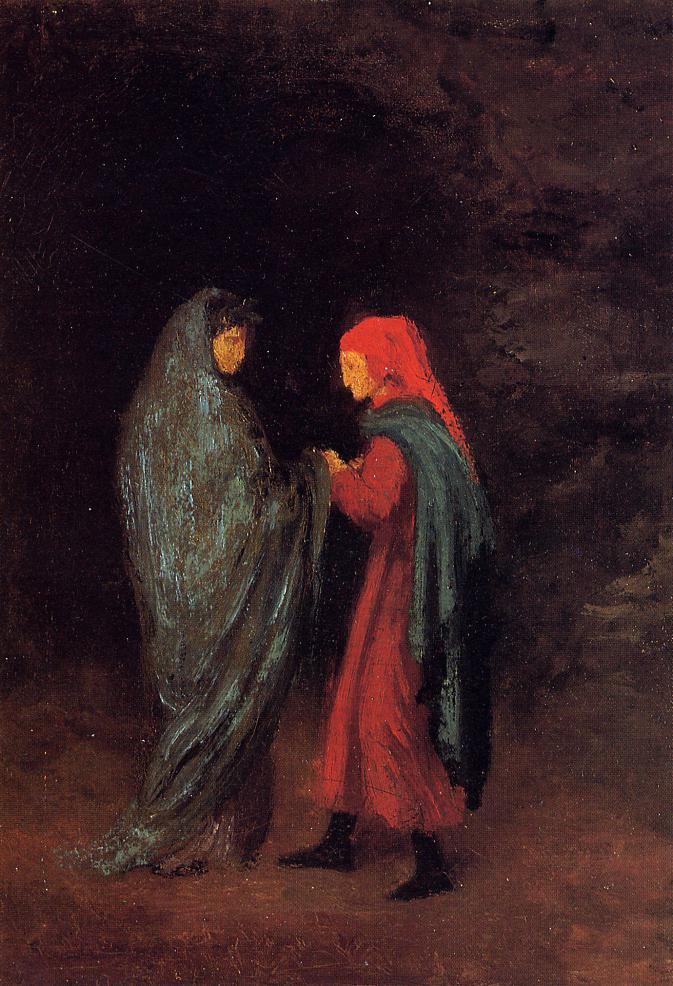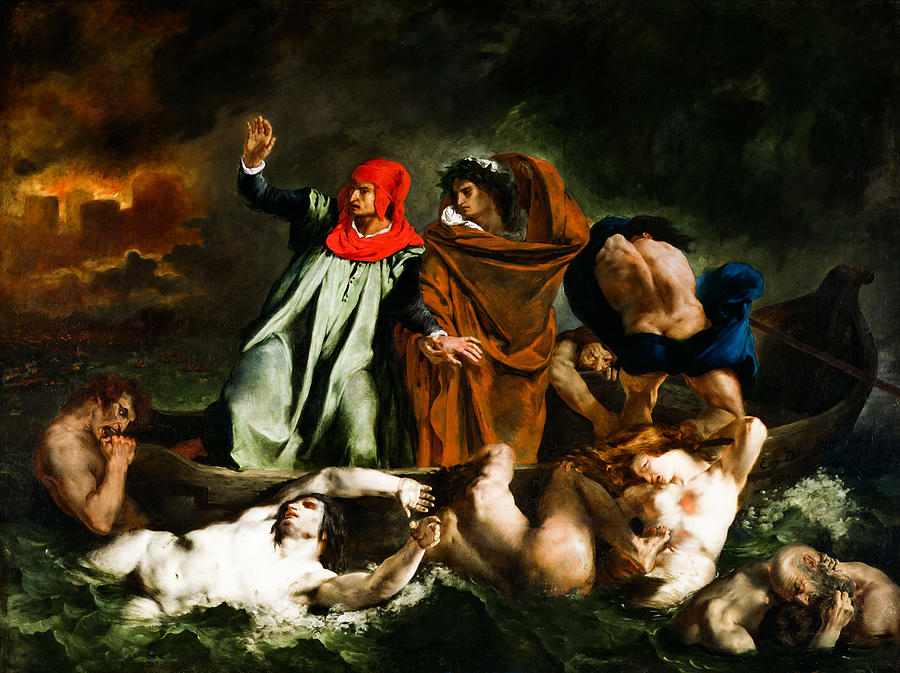
"Canto 4 Dante and Virgil Visit the Great Poets of Antiquity" Eric Armusik Artwork on USEUM
Dante's 'Inferno' is a journey to hell and back. Written more than 700 years ago, this terrifying epic poem is filled with damned souls, including Cleopatra, Judas Iscariot, and Dante's own enemies.

Pin on Dante's Inferno Painting Series
Dante is guided by the Roman poet Virgil, who represents the epitome of human knowledge, from the dark wood through the descending circles of the pit of Hell (Inferno). Passing Lucifer at the pit's bottom, at the dead centre of the world, Dante and Virgil emerge on the beach of the island mountain of Purgatory.

Detail of Panel 3 of 40. "Dante and Virgil at the Entrance to Hell" oil on 48 x 60
Summary: Canto IX. Dante grows pale with fear upon seeing Virgil's failure. Virgil, who appears to be waiting for someone impatiently, weakly reassures Dante. Suddenly, Dante sees three Furies—creatures that are half woman, half serpent. They shriek and laugh when they notice Dante, and call for Medusa to come and turn him into stone.

Dante and Virgil to Hell Painting by Hippolyte Flandrin Pixels
Dante narrates The Divine Comedy in the first person as his own journey to Hell and Purgatory by way of his guide Virgil, the poet of Roman antiquity who wrote the Aeneid, and then to Heaven,.

Dante and Virgil Museum of Fine Arts, Boston
Free Shipping Available. Buy on eBay. Money Back Guarantee!

Dante and Virgil at the Entrance to Hell, 1857 1858 Edgar Degas
Are Dante and Virgil Real People? Yes, both Dante and Virgil were real people. Here's where it gets confusing, though: Dante and Virgil lived in different historical eras. They never met in real life. Dante, the author of the Divine Comedy, included himself and Virgil as characters in his epic poem.

Dante and Virgil in the Second Circle in Hell Painting Joseph Anton Koch Oil Paintings
Virgil The only character besides Dante to appear all the way through Inferno, Virgil's ghost is generally taken by critics to represent human reason, which guides and protects the individual (represented by Dante/Everyman) through the world of sin. As befits a character who symbolizes reason, Virgil proves sober, measured, resolute, and wise.

Dante and Virgil in the Ninth Circle of Hell (Inferno, Canto XXXIV) Dante Alighieri, Divina
The Divine Comedy ( Italian: Divina Commedia [diˈviːna komˈmɛːdja]) is an Italian narrative poem by Dante Alighieri, begun c. 1308 and completed around 1321, shortly before the author's death. It is widely considered the pre-eminent work in Italian literature [1] and one of the greatest works of Western literature. [2]

Dante and Virgil Museum of Fine Arts, Boston
Dante and Virgil then pass over the stream, go through the seven gates, and reach a green meadow. Dante recognizes the figures of authority dwelling there, and as the poets stand on a small hill, Dante gives the names of rulers, philosophers, and others who are there and regrets that he does not have time to name them all. Prominent among the.

Dante and Virgil in Hell by Eugene Delacroix Painting by Orca Art Gallery Fine Art America
Dante and Virgil in Hell is an 1850 oil-on-canvas painting by the French academic painter William-Adolphe Bouguereau. It is in the Musée d'Orsay in Paris. [1] The painting depicts a scene from Dante's Divine Comedy, which narrates a journey through Hell by Dante and his guide Virgil.

Dante and Virgil a photo on Flickriver
Anger: Dante and Virgil are threatened by the Furies when they try to enter through the walls of Dis (Satan). This is a further progression in Dante's evaluation of the nature of sin; he also begins to question himself and his own life, realizing his actions and nature could lead him to this permanent torture.

Dante and Virgil in the Ninth Circle of Hell, Gustav Doré, oil on canvas, 1861 r/Art
Inferno ( Italian: [iɱˈfɛrno]; Italian for "Hell") is the first part of Italian writer Dante Alighieri 's 14th-century epic poem Divine Comedy. It is followed by Purgatorio and Paradiso. The Inferno describes Dante's journey through Hell, guided by the ancient Roman poet Virgil.

Dante Vs Vergil HD desktop wallpaper Widescreen High Definition Fullscreen
Over 27,000 video lessons and other resources, you're guaranteed to find what you need. Learn faster. Stay motivated. Study smarter.

“Dante and Virgil in Vallombrosa” by James Smetham, 182189
Dante and Virgile William-Adolphe Bouguereau 1850. Musée d'Orsay, Paris Paris, France. where Dante, accompanied by Virgil, watches a fight between two damned souls: Capocchio, a heretic and alchemist is attacked and bitten on the neck by Gianni Schicchi who had usurped the identity of a dead man in order to fraudulently claim his.

“Dante and Virgil” by Baron Henri de Triqueti (180374)
The Divine Comedy: A Synopsis. The Divine Comedy is an epic poem by the Dante Alighieri in which the character Dante must travel through Hell and Purgatory with the aid of Virgil before he is brought into Heaven by the first love of his life, Beatrice. The poem is not only the story of an imagined physical journey through the afterlife but also.

Dante vs Virgil Artwork by HDSilver on DeviantArt
Within the Inferno the relationship between Dante and Virgil is an important one. As mentioned, Dante uses their relationship to contrast the good with the bad, between what is ideal and what was rejected in earthly life therefore meriting for the soul their predicaments in Hell. Hell is a loveless and truthless place.